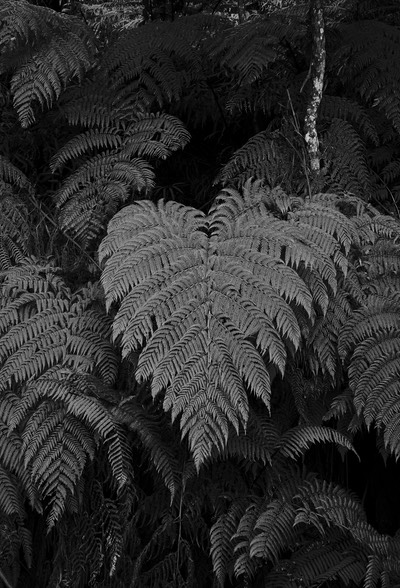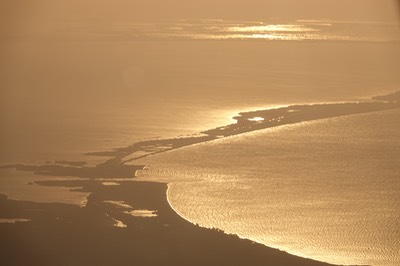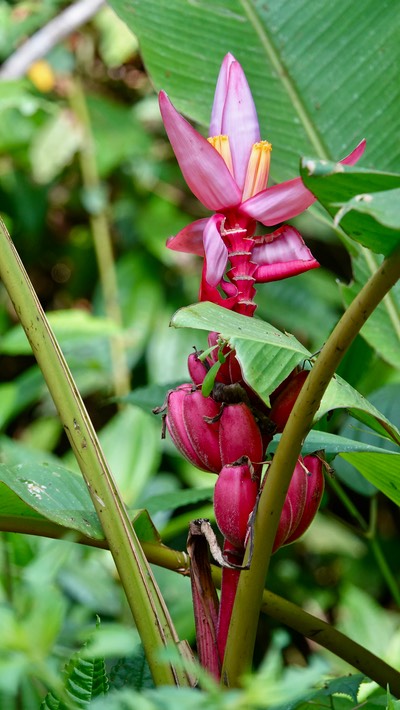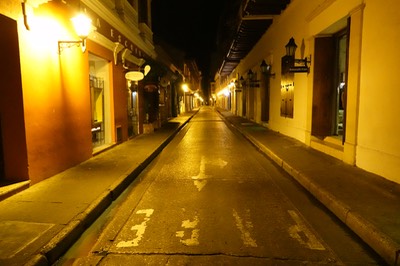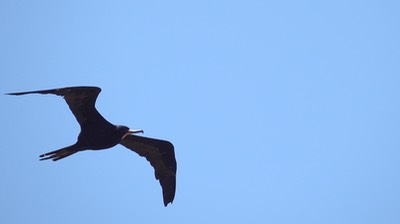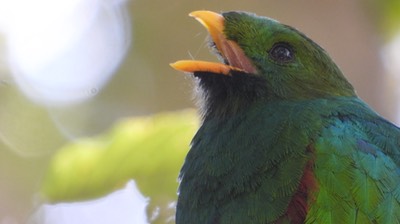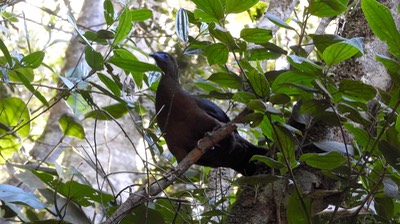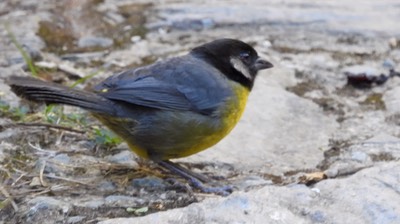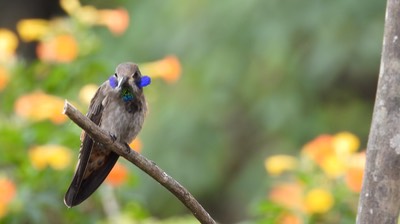In January 2020 I spent a week at the El Dorado Nature Reserve in the Santa Marta Mountains of Northern Colombia. I also spent a week in Cartagena. In January 2024 I spent ten days on Cerro Montezuma. Both visits are discussed below.
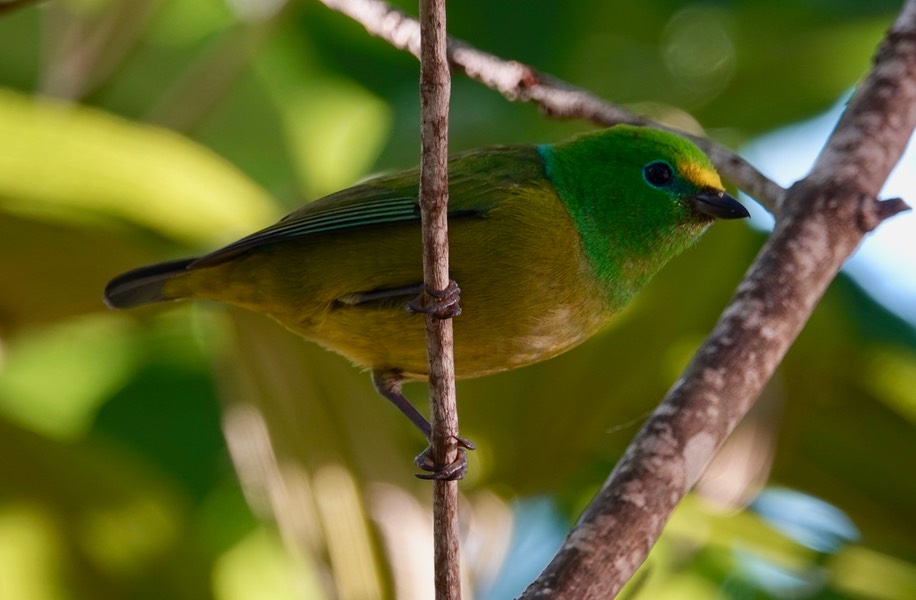
Blue-naped Chlorophonia, Chlorophonia cyanea
The lodge at the Reserve has fruit and nectar feeders which attact a number of hummingbird species as well as species like the Blue-naped Chlorophonia pictured above. The accommodations and food at the lodge are excellent. There are a number of trails which are accessible from the lodge.
Photographs of bird species taken on this trip are found in the Birds of Colombia photo gallery. The portfolio of video recordings made in Colombia is found at this link. Among the bird species photographed and/or recorded on video (the words “photograph” and “ video” are links) from the Caribbean coast of Colombia, Ciénaga, Cartagena, and the Santa Marta mountains are:
- Santa Marta Brush-Finch - photograph and video;
- Stripe-headed Brush-Finch - photograph and video;
- Yellow-headed Caracara - photograph and video;
- Blue-naped Chlorophonia - photograph and video;
- Neotropic Cormorant - photograph;
- Eared Dove - photograph and video;
- Rock Dove - photograph;
- White-tipped Dove - photograph and video;
- Snowy Egret - photograph and video;
- Southern Emerald-Toucanet - photograph and video;
- Social Flycatcher - photograph;
- Montane Foliage-gleaner - photograph and video;
- Magnificient Frigatebird - photographs and video;
- Golden-breasted Fruiteater - photographs and video;
- Great-tailed Grackle - photograph and video;
- Common Ground-Dove - photograph and video;
- Band-tailed Guan - photograph and video;
- Sickle-winged Guan - photographs and video;
- Black-chested Jay - photographs and video;
- Great Kiskadee - photograph and video;
- Southern Lapwing - photograph and video;
- Crested Oropendola - photograph and video;
- Brown-throated Parakeet - photographs and video;
- Scaly-naped Parrot - photographs and video;
- Yellow-crowned Parrot - photograh and video;
- Brown Pelican - photograph and video;
- Lined Quail-Dove - photographs and video;
- White-tipped Quetzal - photograph and video;
- Northern Screamer - photograph and video;
- Bay-headed Tanager - photograph and video;
- Black-capped Tanager - photograph and video;
- Large-billed Tern - photograph and video;
- Royal Tern - photograph;
- Black-hooded Thrush - photographs and video;
- Pale-eyed Thrush - photographs and video;
- Masked Trogon - photographs and video;
- Brown Violetear - photograph and video;
- Green (Lesser) Violetear - photograph and video;
- Sparkling Violetear - photograph and video;
- Black Vulture - photograph;
- Turkey Vulture - photograph;
- Blackburnian Warbler - photograph;
- Montane Woodcreeper - photographs and video;
- Plain-brown Woodcreeper - photograph and video;
- (Violet) Crowned Woodnymph - photograph and video;
- Crimson-crested Woodpecker - photograph and video;
- Red-crowned Woodpecker - photograph and video;
- Black-fronted Wood-Quail - photograph and video;
- Santa Marta Woodstar - photograph and video; and
- Rufous-breasted Wren - video.

Gray-handed Night-Monkey, El Dorado Reserve
The El Dorado Reserve is also a great place to study flora, insects, and mammals. While there, I was able to video four mammal species and photograph a few butterflies:
- Central American Agouti - photographs and video
- Kinkajou - photographs and video
- Gray-handed Night-Monkey - photographs and video
- Red-tailed Squirrel - photographs and video
- Marpesia corinna (photographs)
I spent a week in the old city of Cartagena, that is the walled city. I attempted to book a room at the Centro Hotel through booking.com. The booking company emailed that the transaction had failed so I booked a room at the hotel through Travelocity. Later, I found that booking.com had subsequently made the booking and was refusing to rectify a transaction which they had made without my permission. Neither booking.com nor Centro Hotel have agreed to rectify their error. Neither company is worthy of your business.
That aside, Centro Hotel has nice staff and is centrally located within the walled city. Bring ear plugs!!
Cartagena is a wonderful city and like many wonderful cities is overrun with tourists at times, because it is a wonderful city. When the cruise ships come in the streets are a mass of people (the photographs in the galleries were almost universally taken early in the morning before the tourists had made it in from the “boat”). The mass of bored naive cruise ship people brings out the hawkers, all selling the same hats (the sun is intense), coffee bean braclets, cold water, and “experiences” bored tourists sometimes crave. Cruise ship visiting time is a time to find somewhere else to be. Photographs and video (of the non-bird world) of this part of northern Colombia are found at Northern Colombia.
The cruise ship people seem to walk around in large groups with a guide who shows them the outside of some church and then ushers them off to some shop which may be selling emeralds (for which Colombia is famous) - be cautious and knowledgeable. It is, in my opinion, an experience hardly different from watching television.
As with any locale, if you can get away from the hawkers take the time to interact with the locals. They are friendly and easy going.
Cerro Montezuma
Cerro Montezuma is an extraordinary birding location in the Choco Cloudforest of northwestern Colombia. In the range of 550 bird species (many Colombian endemics), 450 species of orchids, and roughly 700 species of butterflies are found there. I used the Montezuma EcoLodge as my base of operations. It is located just inside the park boundary at about 1350 meters (4,ooo’) in elevation. A rough track leads from the EcoLodge to the summit of the mountain at about 2,600 meters (8,000’) in elevation. The 14 kilometers between the EcoLodge and the gated military communication site at the summit takes about an hour and a quarter to traverse in a high clearance four-wheel drive vehicle.
I made all my arrangements directly through the lodge, but tours travel through the area regularly. All of the arrangements transpired flawlessly, everything from airport pick-up and drop-off, to the driver and vehicle being ready at 5:30 a.m. to take me up the mountain, to dinner, was on time. The food was good, the rooms were nice, the water was hot, the guides were good. I really recommend this place.
If you are focused on video and photography, like I am, this locale can be difficult because it is a cloud forest and the vegetation is thick.
Photographs and video (of the non-bird world) of this part of Colombia are found at the Northern Colombia page. If you are a butterfly person you will find this .pdf of interest - a gallery of the butterflies found on Cerro Montezuma.
Photographs of bird species taken on this trip are found in the Birds of Colombia photo gallery. The portfolio of video recordings made in Colombia is found at this link. Among the bird species photographed and/or recorded on video (the words “photograph” and “ video” are links) from Cerro Montezuma are:
Crested Ant-tanager (video and photograph)
Ochre-breasted Antpitta (video and photograph)
Bananaquit (video and photograph)
Empress Brilliant (video and photograph)
Green-crowned Brilliant (photograph)
Black-headed Brushfinch (video and photograph)
Choco Brushfinch (video and photographs)
Black-chested Buzzard-Eagle (photograph)
Chestnut-breasted Chlorophonia (video and photographs)
Dusky Chlorospingus (video and photographs)
Buff-tailed Coronet (photographs)
White-capped Dipper (video and photograph)
Andean Emerald (video and photographs)
Thick-billed Euphonia (video and photographs)
Black Flowerpiercer (video and photographs)
Chestnut-breasted Flowerpiercer (video and photograph)
Masked Flowerpiercer (photographs)
White-sided Flowerpiercer (photographs)
Cinnamon Flycatcher (video and photographs)
Handsome Flycatcher (photograph)
Rusty-margined Flycatcher (video and photographs)
Western Ornate Flycatcher (video and photograph)
Buff-throated Foliage-gleaner (photographs)
Barred Fruiteater (video and photograph)
Green-and-black Fruiteater (video and photograph)
Orange-breasted Fruiteater (video and photograph)
Scaled Fruiteater (video and photograph)
Wattled Guan (photograph)
Western Tawny-bellied Hermit (video and photograph)
Rufous-gaped Hillstar (video and photographs)
Green Honeycreeper (video and photograph)
Rufous-tailed Hummingbird (video and photographs)
Brown Inca (photographs)
Collared Inca (video, video, and photographs)
White-necked Jacobin (video and photographs)
Black-chested Jay (video and photograph)
Ringed Kingfisher (video and photograph)
Broad-billed Motmot (video and photograph)
Highland (Andean) Motmot (video and photograph)
Black-chinned Mountain-Tanager (video and photograph)
White-faced Nunbird (video and photographs)
Chestnut-headed Oropendola (video and photographs)
Yellow-billed Oropendola (video and photographs)
White-winged (Black) Phoebe (video, video, and photograph)
Olivaceous Piha (video and photograph)
Booted Racket-tail (video and photograph)
Blackish Rail (video and photograph)
Slate-throated Redstart (video and photographs)
Buff-throated Saltator (video and photographs)
(Colombian) Rufous Spinetail (video and photographs)
Rufous-collared Sparrow (video and photographs)
Tourmaline Sunangel (video and photographs)
Brown-bellied Swallow (photographs)
Southern Rough-winged Swallow (video and photographs)
Long-tailed Sylph (video and photographs)
Violet-tailed Sylph (video and photographs)
Beryl-spangled Tanager (photographs)
Black-and-gold Tanager (video and photographs)
Blue-capped Tanager (video and photograph)
Blue-gray Tanager (video and photograph)
Blue-necked Tanager (photograph)
Crimson-backed Tanager (video and photograph)
Flame-rumped Tanager (video and photograph)
Glistening-green Tanager (photographs)
Gold-ringed Tanager (video and photographs)
Golden Tanager (video and photographs)
Golden-hooded Tanager (photographs)
Grass-green Tanager (video and photograph)
Lemon-rumped Tanager (video and photograph)
Palm Tanager (video and photograph)
Purplish-mantled Tanager (video and photograph)
Rufous-throated Tanager (photograph)
Scrub Tanager (video and photograph)
Silver-throated Tanager (video and photograph)
Green Thorntail (video and photographs)
Black-billed Thrush (video and photograph)
Glossy-black Thrush (video and photograph)
Swainson’s Thrush (video and photograph)
Black-headed Tody-flycatcher (photographs)
Black-throated Tody-Tyrant (video and photograph)
Choco Toucan (video and photograph)
Masked Trogon (video and photograph)
Golden-faced Tyrannulet (photographs)
American Black Vulture (video and photograph)
Northern Waterthrush (video and photograph)
Golden-fronted Whitestart (video and photographs)
Plain-brown Woodcreeper (video and photographs)
(Violet) Crowned Woodnymph (video and photographs)
Black-cheeked Woodpecker (video and photograph)
Purple-throated Woodstar (video and photographs)
Munchique Wood-Wren (video and photographs)
Other videos include:
Central American Agouti (video and photograph)
Ants (video)
Beetle (video and photographs)
Crab-eating Fox (video and photograph)
Red-tailed Squirrel (video and photograph)
Adelpha levona - (photographs)
Adelpha salmoneus emilia - (photograph)
Adelpha serpa celerio (photographs)
Anartia amathea amathea - (photographs)
Ancyluris inca huascar - (photographs)
Danaus plexippus megalippe, Monarch - (photograph)
Dismorphia theucharila avonia (video and photographs)
Dragonfly (video and photograph)
Eurytides colombu - (photographs)
Forsterinaria pyrczi - (photographs)
Graphita griphe - (photographs)
Historis odius - (photographs)
Lycorea ilione lamirus (video and photographs)
Megeuptychia antonoe - (photographs)
Morpho helenor macrophthalmus (video and photograph)
Oospila agnetaforslundae - (photograph)
Opaon varicolor - (photograph)
Oressinoma typhla typhla - (photograph)
Pantherodes pardalaria - (photographs)
Potamanaxas tschotky - (photograph)
Pronophila orcus orcus - (photographs)
Saliana salius - (photograph)
Road video - Montezuma EcoLodge to Summit
